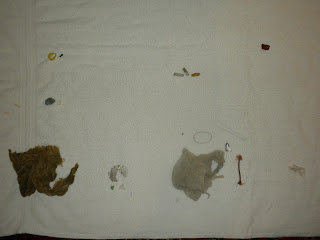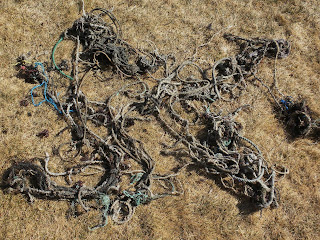From Dec 2010 - Feb 2011, I collected, on average
180 pieces of manmade debris at my beach, Bayview, in Saco, Maine each week.
From Dec 2011 - Feb 2012, that number was an average of
60 pieces each week!
Anyone following my Collection Reports has seen that the amount of debris I'm pulling off the beach has nosedived. It would be very tempting to see this as amazing news. I'd be tempted too, if not for all the research I'm now conducting simultaneously on a second beach further south.*
 |
This, plus 153 individual scraps of fishing rope, came from my
second beach, Curtis Cove in Biddeford, for a total of 249
pieces of junk from 150 ft of shoreline. In one week in Feb. |
No, the debris is still swirling in the Gulf of Maine, as fiercely as ever. But for some reason, starting in mid-November, it largely stopped washing up on Bayview beach.
Why?
There are two really intriguing possibilities. The first has to do with a strange phenomenon called
internal waves. The ocean isn't one big homogenous lump of water. It is stratified -- often sharply -- with fresh, "light" layers on top and saltier, "dense" layers down below. When the stratification is strong, energy that gets put into the ocean (from storm or surface wind, etc.) can propagate along the boundaries between those layers. It's the cause of what's known as "
dead water" -- when, say, a boat propellor that usually pushes the boat forward instead sends all its energy just into creating these underwater waves, and the boat hardly moves at all.
What does this have to do with beach debris? Well if the winter of 2010/11 was a time of high stratification between layers, more ocean energy may have traveled through these undersea conduits, churning up the seabottom and its debris. This huge wrackline from December 2010...
...may have gotten its beginnings from a churned-up seafloor thanks to shallow-water internal waves. Contrast that view with this winter's:
All winter long there has been almost zero seaborne wrack. No wrack = no plastic. Are the internal waves weaker this year, or even shut down? It's been an exceptionally mild winter in Maine. Freakishly mild. Does Saco Bay need bone-chilling air masses to stratify its waters in winter? We've also had fairly little rain or snow all winter long. Does the bay need fresh river runoff to stratify it?
I don't know. But it's one thought, and it's got some support from oceanographers I've spoken with.
The second thought comes from the few curious finds that
have surfaced. Twice in the past month, I've pulled from the sands pulltab-era aluminum tops from old rusted-away steel cans.
 |
| 2/29: Generic style used ~1970-1980 |
 |
| 3/12: Coke can used only '71-'72 |
A third 30+ year-old pulltab aluminum top down in Curtis Cove makes 3 in a month! Which makes me wonder if an offshore sandbar has shifted, revealing 30-year-old flotsam and dampening the energy coming into Bayview. Just this week, at an ultralow low-tide, I snapped this muddy bar which peeked out of the water at the very edge of the tide line:
I've never seen anything like a sandbar exposed out at Bayview before. The ripples show that it's migrating landward. If it has bigger cousins just offshore, and they're steep enough to cut off inflow of seafloor debris, that may be what's stopping the debris from coming in.
As usual, I have more questions than answers. Clearly there's some energy at the beach. I've documented huge
sandloads dumped up on the shore this winter, as well as
several lobster traps. Yet the stuff that would get whipped up, suspended, and dragged in -- like vinyl, polystyrene, seaweed -- it's just not coming.
Whatever's keeping it from coming in, it's out there. And it will start washing into Bayview again. It's just a question of when. For the moment, it leaves me with the tantalizing question of "Why?"
* More specifics on this beach, Curtis Cove in Biddeford, in a future post, soon!


















































